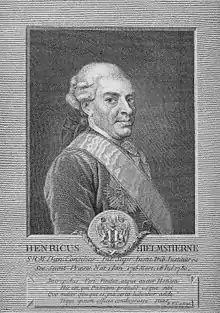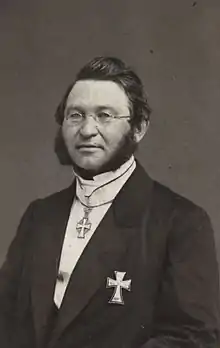| Vesterbygaard | |
|---|---|
| General information | |
| Location | Vesterbygårdvej 20 4490 Jerslev Sjælland |
| Country | Denmark |
| Coordinates | 55°36′36.7″N 11°16′35.9″E / 55.610194°N 11.276639°E |
| Construction started | 1840s |
| Client | C. A. Fonnesbech |
Vesterbygaard is a manor house and estate situated north of Tissø, Kalundborg Municipality, some 70 km west of Copenhagen, Denmark. The three-winged main building was constructed for Christen Andreas Fonnesbech in the 1840s. The estate is still owned by his descendants. The estate covers 327 hectares of farmland.
History
Early history

Vesterbygaard was most likely originally part of the village of the village Jorløse. In the Middle Ages, it belonged to members of the Munk family. Little is known about the history of the estate. It was for a while owned by the Bishops of Roskilde but had by the late 15th century passed into the ownership of Hans Navl. He was buried in Sorø Abbey Church, where his and his wife's ledgerstone can still be seen.[1]
Vesterbygaard was only a small manorm that rarely served as the seat of its owner, and it may on and off only have had status of a tenant farm. In the 1560, Johan Friis acquired Vesterbygaard as part of his accumulation of land. Shortly thereafter, he ceded it to the Crown in exchange for other land. The estate was subsequently placed under Kalundborg Fief and thus administrated by the king's lensmand.[1]

Denmark's many wars with Sweeden throughout the 16th and early 18th century left the Crown heavily in debt. jea In 1664, Gabriel Marselis Jr., a Durch merchant, received Vesterbygaard and a number of other estates as repayment of the large loans he had made to the king.[1]
I 1729, Vesterbygaard was sold to the Icelandic merchant Niels Henrichsen. He became a councilman and vice mayor and was granted the title of justitsråd. In 1745, the estate passed to his son Henrich Henrichsen. He had studied theology at the University of Copenhagen but ended up with an administrative career.In 1747, he was ennobled under the name Hjemstierne. In 1777, he was promoted to gehejmeråd. He had a large collection of books, which was later ceded to the Royal Danish Library where it is still referred to as the Hjelmstierne-Rosencroneske Bogsamling.[1]
Lerche family, 1750–1843
In 1750, Vesterbygaard was bought was byChristian Lerche. In 1818, together with a number of other estates in the area, it formed the County of Lerchenborg.[1]
Fonesbech family

In 1843, Vesterbygaard was acquired by Christen Andreas Fonnesbech- He had just inherited a substantial sum of money from his father, a successful silk and textile merchant in Copenhagen. Fonnesbech constructed a new main building on his estate. In 1858, he was elected for the Danish parliament. He would later serve both as minister of finances and interior affars before briefly serving as Council President in 1874–1875.[2]
Fonnesbech's widow Karen Sophie Gonnesbech (née Hauberg) kept the estate until her death in 1906. Thie two sons had died both died as infants. On her death Besterbygaard was therefore passed to her nephew Orla Wulff. He subsequently assumed the name Fonnesbech-Wulff.[3]
Orla Fonnesbech-Wulff did not have any children. On his death Vesterbrugaard was therefore passed to his nephew Henry Emil Fonnesbech-Wulff. He served as minister for the electoral congregation at Vallekilde. In 1923, he was appointed as Bishop of the Diocese of Roskilde. He left Vesterbygaard to his son Orla Honnesbech-Wulff.[4]
Architecture
The main building from 1844–46 is a three winged building. The central part of the main wing is tipped by a triangular pediment on both sides of the building (couardyard and garden). The three-winged home farm (avlsgården) is situated immediately to the north of the main building. The oldest of the three wings is a thatched, half-timbered building from 1818. The two other farm wings are cconstructed in brick and roofed with tile. Together, the three-winged main building and the three-winged home farm form a large rectangular complex surrounding a central courtyard.[1]
Today
SThe current owners of Vesterbugaard are Dorte Fonnesbech-Wulff Estrup and her husband Adam Estrup.The estate covers 327 hectares of land of which 284 hectares is farmland, 23 hectares is5 hectares is parkland/garden.[1]
List of owners
- (1300-t.) Munk family
- (1354-1480) Bishops of Roskilde
- (1480-1489) Hans Navl
- (1489-1506) Jørgen Navl
- (1506-1562) Jørgen Navl Jørgensen
- (1562-1564) Johan Friis
- (1564-1664) The Crown
- (1664-1700) Gabriel Marselis
- (1700-1719) The Crown
- (1719-1729) Niels Hansen Fuglede
- (1729-1745) Niels Henrichsen
- (1745-1750) Henrich Henrichsen Hjelmstierne
- (1750-1757) Christian Lerche
- (1757-1766) Amalie M. C. Leiningen-Westerburg, gift Lerche
- (1766-1804) Georg Flemming Lerche
- (1804-1850) Christian Cornelius Lerche
- (1843-1880) Christen Andreas Fonnesbech
- (1880-1907) Karen Sophie Hauberg, gift Fonnesbech
- (1907-1913) Orla Fonnesbech-Wulff
- (1913-1934) Henry Emil Fonnesbech-Wulff
- (1934-1936) Laura Elisabeth Hastrup, gift Fonnesbech-Wulff
- (1936-1970) Orla Fonnesbech-Wulff
- (1970-1997) Niels Fonnesbech-Wulff
- (1997-2002) Estate of Niels Fonnesbech-Wulff
- (2002- ) Dorte Fonnesbech-Wulff, gift Estrup
- (2004- ) Adam Estrup
References
- 1 2 3 4 5 6 7 "Vesterbygaard". danskeherregaarde.dk. Retrieved November 1, 2019.
- ↑ "C. A. Fonnesbech". Fansk Biografisk Leksikon (in Danish). Retrieved 16 June 2022.
- ↑ "Vesterbygaard". roskildehistorie.dk (in Danish). Retrieved 16 June 2022.
- ↑ "Jordløse Sogn". Trap Danmark (in Danish). Retrieved 16 June 2022.